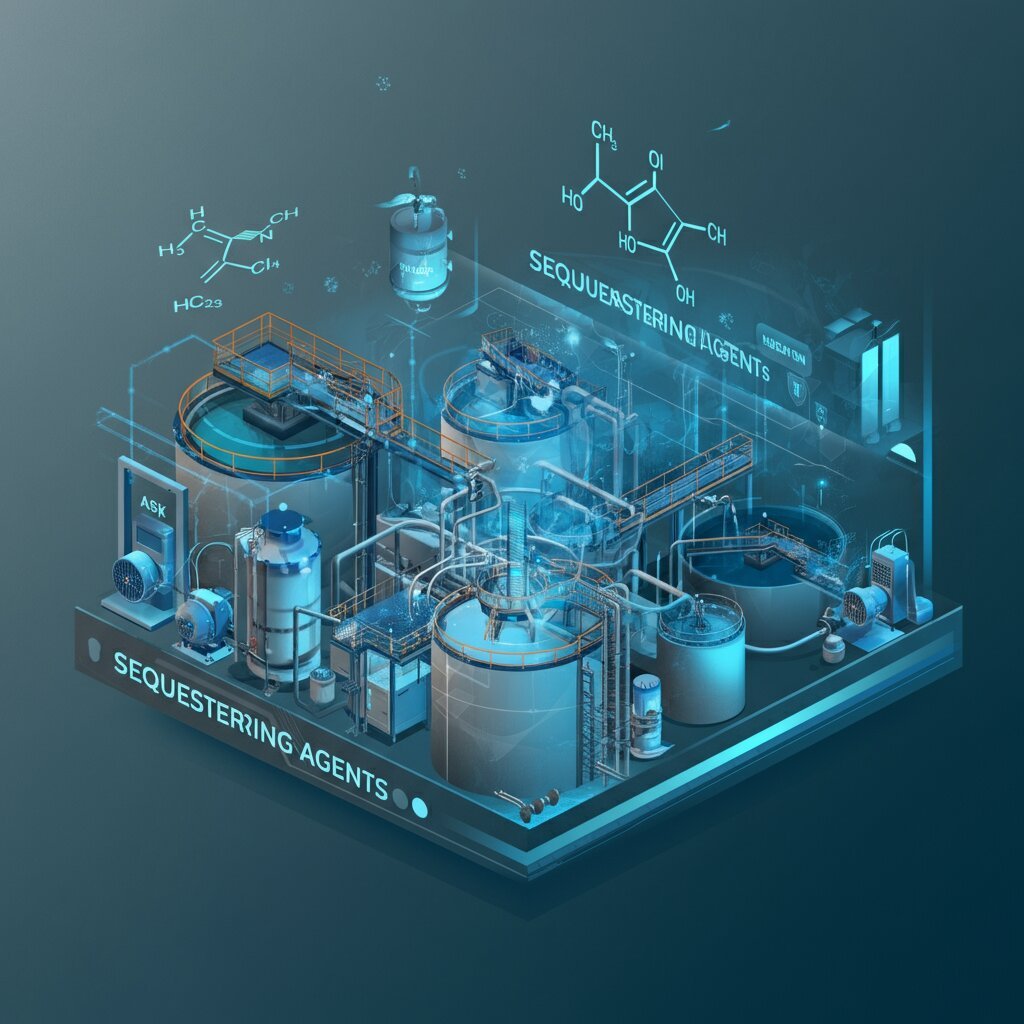Have you ever wondered why your detergent works so well, even in hard water? Or how textiles achieve perfectly even colors? The answer often lies with an unsung hero of industrial chemistry: the sequestering agent. These powerful compounds work behind the scenes, improving the performance and efficiency of countless processes. They are essential for any application where metal ions can cause problems.
This guide will explore the world of sequestering agents. We will break down what they are, how they function, and why they are indispensable across major industries. You will see how these specialty chemicals solve complex problems in water treatment, detergents, and textile manufacturing, leading to better products and more reliable outcomes.
What Are Sequestering Agents?
A sequestering agent, also known as a chelating agent, is a chemical compound that binds tightly with positively charged metal ions. Think of it like a claw that grabs onto and isolates troublesome metal ions, such as calcium, magnesium, iron, and copper. By forming a stable, water-soluble complex with these ions, the agent effectively “sequesters” or locks them away. This action prevents the metal ions from reacting with other substances and causing unwanted effects.
The primary problem that sequestering agents solve is the interference of metal ions. In hard water, for example, calcium and magnesium ions react with soap to form a scummy residue called soap scum. This scum reduces cleaning power and leaves deposits on surfaces. A sequestering agent in a detergent formula will bind to these calcium and magnesium ions first, allowing the soap to do its job effectively.
The strength and stability of the bond they form are what make these agents so valuable. They essentially neutralize the negative impact of metal ions, ensuring that chemical processes run smoothly and products perform as expected.
The Critical Role of Sequestration in Key Industries
The ability to control metal ions gives sequestering agents a vital role in many industrial applications. From ensuring pure water to producing high-quality fabrics, their impact is widespread. Let’s look at three sectors where they are particularly important.
1. Water Treatment and Purification
Water, the universal solvent, often contains dissolved mineral ions. While some are harmless, others can cause significant problems in both industrial and municipal water systems. This is where sequestering agents for water treatment become essential.
Preventing Scale Buildup: Calcium and magnesium ions are notorious for causing scale buildup in pipes, boilers, and cooling towers. This scale reduces water flow, impairs heat transfer, and can lead to equipment failure. Sequestering agents bind to these ions, keeping them dissolved in the water and preventing them from precipitating out as scale. This extends the life of equipment and improves operational efficiency.
Controlling Metal Contamination: Industrial wastewater can contain heavy metal ions like copper, lead, and iron. These metals can be toxic and environmentally harmful. Sequestering agents are used to bind with these heavy metals, making them easier to remove during the wastewater treatment process. This ensures that the discharged water meets environmental safety standards.
Common examples of sequestering agents used in water treatment include Ethylenediaminetetraacetic acid (EDTA) and various phosphonates. These compounds are highly effective at managing a wide range of metal ions found in water sources.
2. Enhancing the Power of Detergents and Cleaners
The cleaning industry relies heavily on the performance of its products. The effectiveness of a detergent can be severely compromised by hard water. Sequestering agents are a key ingredient in modern cleaning formulations, ensuring consistent results regardless of water quality.
Boosting Cleaning Efficiency: As mentioned earlier, metal ions in hard water react with surfactants (the primary cleaning ingredients) to form insoluble soap scum. This deactivates the surfactants and reduces their cleaning power. By sequestering calcium and magnesium ions, these agents allow the surfactants to focus on lifting dirt and stains. The result is cleaner clothes, shinier dishes, and more effective household and industrial cleaners.
Improving Product Stability and Appearance: Trace metal ions, like iron and copper, can act as catalysts that degrade other ingredients in a liquid detergent, such as fragrances, dyes, and enzymes. This can lead to discoloration, loss of scent, and reduced shelf life. A sequestering agent stabilizes the formula by deactivating these metal ions, preserving the product’s quality and appearance over time.
Citrates, polyphosphates, and EDTA are frequently used in detergent formulations to achieve these benefits. Their inclusion is a primary reason why modern detergents perform so well across different conditions.
3. Achieving Perfection in Textile Processing
The textile industry demands precision, especially during dyeing and finishing. Uncontrolled metal ions present in the water or on the fabric can lead to disastrous results, such as uneven colors, shade changes, and poor fabric feel. Sequestering agents in textile processing are crucial for quality control.
Ensuring Uniform Dyeing: Metal ions, particularly iron and copper, can react with dyes. This can alter the dye’s color or cause it to bind unevenly to the fabric, resulting in spots, streaks, and inconsistent shades. Sequestering agents are added to the dye bath to neutralize these disruptive metal ions. This ensures that the dye can penetrate the fabric uniformly, leading to level, vibrant, and repeatable colors.
Improving Bleaching and Scouring: Before dyeing, fabrics undergo scouring (cleaning) and bleaching processes. Trace metals can decompose the bleaching agents (like hydrogen peroxide) too quickly, potentially damaging the fabric fibers. Sequestering agents control the release of the bleaching agent by managing metal ion activity. This results in a more effective and safer bleaching process, producing a perfect white base for dyeing.
Specialty phosphonates and other chelating agents are designed specifically for the high-temperature and high-pH conditions found in textile dye houses.
Choosing the Right Sequestering Agent
Not all sequestering agents are created equal. The right choice depends on the specific application, including the types of metal ions present, the pH of the system, and the operating temperature. At Texaux Chemicals, we provide a range of high-performance sequestering agents tailored to meet the unique challenges of your industry. Our technical experts can help you identify the ideal solution to optimize your processes, improve product quality, and enhance efficiency.
By understanding the function of these powerful chemical tools, you can unlock a new level of performance and reliability in your operations.
Frequently asked questions
What are the sequestering agents?
Sequestering agents are chemical substances that bind with metal ions, preventing them from interfering in chemical processes. By forming stable, soluble complexes, they control water hardness, improve dyeing, prevent scaling, and enhance cleaning efficiency. Common examples include EDTA, phosphates, and citrates, widely used in textiles, detergents, and water treatment.
Is EDTA a sequestering agent?
Yes, EDTA (Ethylenediaminetetraacetic acid) is a widely used sequestering agent. It binds strongly with metal ions like calcium, magnesium, and iron, forming stable complexes. This prevents interference in processes such as textile dyeing, water treatment, and detergents. EDTA ensures smooth reactions, improves efficiency, and prevents scaling or precipitation issues.
What is a sequestering agent and chelating agent?
A sequestering agent and a chelating agent are substances that bind with metal ions to prevent undesirable reactions. Chelating agents form stable, ring-like complexes with metals, while sequestering agents keep them inactive in solution. Both improve processes like dyeing, cleaning, and water treatment by controlling hardness and preventing scale formation.
What is an example of a sequestrant?
A common example of a sequestrant is EDTA (Ethylenediaminetetraacetic acid). It binds with calcium, magnesium, and iron ions to prevent scaling, water hardness issues, and unwanted reactions. Widely used in textiles, detergents, food, and water treatment, EDTA ensures process efficiency by stabilizing metal ions and maintaining solution clarity and performance.



